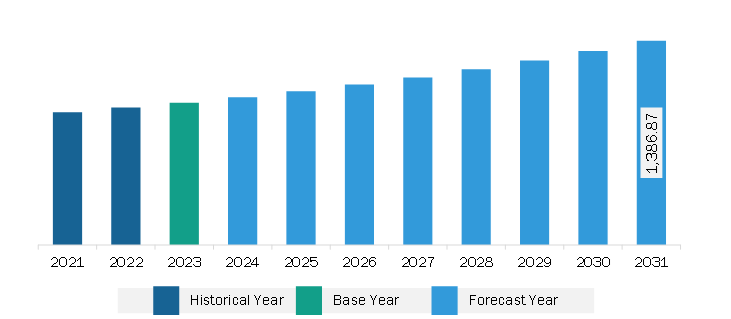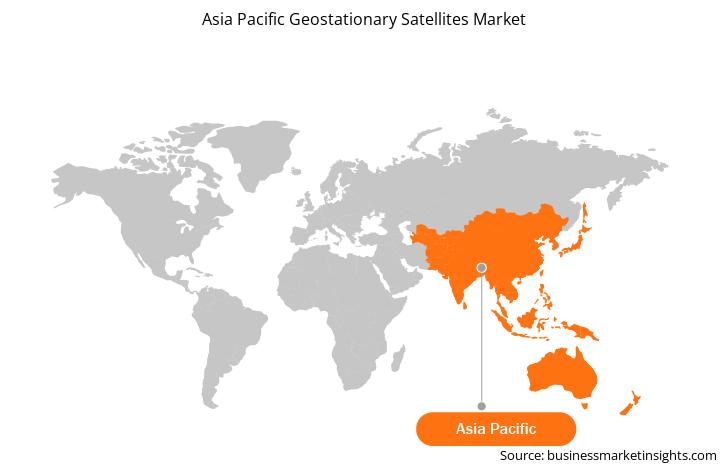The Asia Pacific geostationary satellites market was valued at US$ 966.08 million in 2023 and is anticipated to reach US$ 1,386.87 million by 2031; it is estimated to register a CAGR of 4.6% from 2023 to 2031.
Satellite manufacturers such as Maxar Space Systems, Astranis, Terran Orbital, SWISSto12, and Saturn Satellite Network have already been focusing on the development of small satellites that can be deployed into the GEO orbit. This will further provide relief to the satellite operators and launch companies, reducing their operational costs for placing a satellite into the GEO orbit with lesser size, weight, and cost of manufacturing. During the conference of” SATELLITE 2020,” several satellite companies announced that they have been focusing on the development of smallsat constellations for geostationary orbits that can be deployed through small satellite-specialized launch vehicles, which will ultimately reduce the overall cost of satellite launches and orbit placement of satellites into the GEO orbits. The development of small satellites for deployment into geostationary orbit is likely to generate new opportunities for market vendors in the coming years.
The Asia Pacific geostationary satellite market growth is attributed to the increasing need for improving satellite-based navigation, communication, and several remote sensing applications. China, India, Australia and Japan have a strong focus on the launch of satellites. Key players in the geostationary satellite market in Asia Pacific include Neumann; Beijing Spacecraft Manufacturing Co., Ltd; China Aerospace Science Technology Corporation; and Kongtian Dongli. These companies are renowned for their initiatives to contribute to the progress of space technology. In March 2024, Thaicom Satellite Telecommunications ordered a small geostationary satellite from Astranis—Thaicom-9—which is scheduled for launch in geostationary orbit in 2025. As part of the agreement between Astranis and Space Tech Innovation Limited (Thaicom's subsidiary), Thaicom would deploy the Astranis MicroGEO satellite to provide Ka-band services over Asia. The new satellite is also likely to provide broadband connectivity in the most remote and unconnected areas in Asia.

Strategic insights for the Asia Pacific Geostationary Satellites provides data-driven analysis of the industry landscape, including current trends, key players, and regional nuances. These insights offer actionable recommendations, enabling readers to differentiate themselves from competitors by identifying untapped segments or developing unique value propositions. Leveraging data analytics, these insights help industry players anticipate the market shifts, whether investors, manufacturers, or other stakeholders. A future-oriented perspective is essential, helping stakeholders anticipate market shifts and position themselves for long-term success in this dynamic region. Ultimately, effective strategic insights empower readers to make informed decisions that drive profitability and achieve their business objectives within the market.

| Report Attribute | Details |
|---|---|
| Market size in 2023 | US$ 966.08 Million |
| Market Size by 2031 | US$ 1,386.87 Million |
| CAGR (2023 - 2031) | 4.6% |
| Historical Data | 2020-2021 |
| Forecast period | 2023-2031 |
| Segments Covered |
By Component
|
| Regions and Countries Covered | Asia-Pacific
|
| Market leaders and key company profiles |
|
The geographic scope of the Asia Pacific Geostationary Satellites refers to the specific areas in which a business operates and competes. Understanding local distinctions, such as diverse consumer preferences (e.g., demand for specific plug types or battery backup durations), varying economic conditions, and regulatory environments, is crucial for tailoring strategies to specific markets. Businesses can expand their reach by identifying underserved areas or adapting their offerings to meet local demands. A clear market focus allows for more effective resource allocation, targeted marketing campaigns, and better positioning against local competitors, ultimately driving growth in those targeted areas.

The Asia Pacific geostationary satellites market is categorized into component, application, and country.
Based on component, the Asia Pacific geostationary satellites market is segmented into communication system, power system, propulsion system, and others. The communication system segment held the largest market share in 2023.
In terms of application, the Asia Pacific geostationary satellites market is categorized into communications, space exploration, navigation, earth observation, and others. The communications segment held the largest market share in 2023.
By country, the Asia Pacific geostationary satellites market is segmented into China, India, Japan, South Korea, and the Rest of Asia Pacific. China dominated the Asia Pacific geostationary satellites market share in 2023.
Airbus SE, Ball Corp, Israel Aerospace Industries Ltd, Korea Aerospace Industries Ltd., Lockheed Martin Corp, Northrop Grumman Corp, Thales SA, and The Boeing Co are some of the leading companies operating in the Asia Pacific geostationary satellites market.
The Asia Pacific Geostationary Satellites Market is valued at US$ 966.08 Million in 2023, it is projected to reach US$ 1,386.87 Million by 2031.
As per our report Asia Pacific Geostationary Satellites Market, the market size is valued at US$ 966.08 Million in 2023, projecting it to reach US$ 1,386.87 Million by 2031. This translates to a CAGR of approximately 4.6% during the forecast period.
The Asia Pacific Geostationary Satellites Market report typically cover these key segments-
The historic period, base year, and forecast period can vary slightly depending on the specific market research report. However, for the Asia Pacific Geostationary Satellites Market report:
The Asia Pacific Geostationary Satellites Market is populated by several key players, each contributing to its growth and innovation. Some of the major players include:
The Asia Pacific Geostationary Satellites Market report is valuable for diverse stakeholders, including:
Essentially, anyone involved in or considering involvement in the Asia Pacific Geostationary Satellites Market value chain can benefit from the information contained in a comprehensive market report.